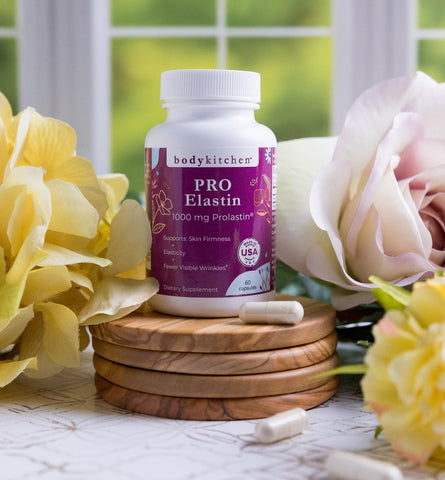Elastin’s Role in Healthy Lung Function
Lungs are to breath what joints are to mobility. And without elastin, lungs would be unable carry out their duties effectively. Every time you breathe in and out, whether you’re exercising, sleeping or simply flowing through your day, elastin in lungs and related tissues is in full engagement.
Strong yet stretchy, elastin fibers provide your lungs with the flexibility to expand and contract like a balloon. And as with other critical proteins in the body, demand for elastin protein is high, both to support normal and healthy lung function, and to help counter the day-to-day stress of aging and pollution.
In fact, the loss of lung elasticity is so detrimental to your quality of life that there’s a connection between impaired elastic recoil of lungs and respiratory conditions such as emphysema and chronic obstructive pulmonary disease.*
Let’s explore elastin’s role in healthy lung function and what you can do to support your lung health as you age.
What is Elastin?
Elastin is a fibrous protein of the extracellular matrix (ECM) – a web of large molecules known to relay and monitor the functions of tissues and cells.
It starts with tropoelastin, the precursor, or parent, to elastin formation. ECM cells release it in soluble units that fill the spaces of the web.* Once released, an enzyme called lysyl oxidase strings together the incoming units into polypeptide chains that form amino acids, the building blocks of elastin protein.*
The assembly process continues as these fully formed stretchy proteins form coil-like elastin fibers that can stretch and recoil with ease.
What Does Elastin Do?
All elastic tissue in the body contains high levels of elastin protein, which is roughly 1,000 times more flexible than the rigid protein, collagen.* This defining feature is what enables lungs, as well as blood vessels, skin, the heart and bladder to retain their expand-and-contract functionality and tensile strength.*
Function of Elastin in Lungs
Lungs are fundamental to the respiratory system, the mechanism by which fresh air enters your body, circulates oxygen through the bloodstream, and carbon dioxide waste gets expelled. Every time you breathe in and out, from shallow chest breathing to calming diaphragmatic breathing, a network of elastic tissues in respiratory organs and muscles engage to make it possible.
Elastin protein is fundamental to the architecture and function of lungs. There are three separate elastin fiber systems that develop independently in the lung, each carrying out a different function. And all three continue forming through adolescence into early adulthood when production of elastin protein naturally diminishes.* As you’ll read about next, this contributes to loss of lung elasticity.
Lung Facts That’ll Take Your Breath Away*
|
# breaths per minute: 12-15 breaths
|
# breaths per day: 17,000 |
# breaths per year: 6 million |
The basic act of breathing occurs in a series of steps:
Step 1: Inhalation
With every respiration, your diaphragm muscle is the first to respond. Situated between your chest and abdomen, the mound-like diaphragm muscle tightens and shifts downward to create more space for your lungs to fill and maximize lung capacity. The contraction creates energy that gets stored in elastic tissue.*
Step 2: Gas Exchange
The air travels to tiny sacs called alveoli. The alveoli are at the end of bronchial tubes and in these bubbles are where oxygen and carbon dioxide are exchanged. Oxygenated air is toted off to the bloodstream by miniature veins bordering the alveoli. And a special membrane that surrounds the alveoli also supports your health in part by blocking liquid in the capillaries from entering.**
Step 3: Exhalation
When you exhale, the energy stored in the elastic tissue upon inhalation is released when the lung recoils and carbon dioxide waste – a byproduct of respiration – is forced out.*
Importance of Lung Capacity
Healthy “young” lungs with well-functioning alveoli sacs have the ability to maximize the volume of air they can take in with ease. When you take a deep breath in and can no longer inhale further, you have reached your total lung capacity – roughly 6 liters, or a little more than 1 ½ gallons, which varies according to age and gender.
Maintaining proper lung capacity is crucial to lung health, because it speaks to the organs’ ability to hold an optimal amount of air in support of oxygen circulation, detoxification and other vital processes.
Lungs peak in maturity between the ages of 20 to 25, then gradually lose functionality past the approximate age of 35.*
Every cell, tissue and system in the body undergoes changes as a result of aging, and the respiratory system is no exception to the rule. In fact, the high concentration of elastin protein in the lungs, diaphragm muscle and other elastic tissue naturally assures that over time the elastic recoil of lungs and supportive tissues and ligaments will degrade.
In addition to diminished functionality that comes with natural aging, loss of lung elasticity is characteristic of excessive pollution, harmful fumes and unhealthy lifestyle habits, such as smoking and vaping.
How to Improve Lung Capacity
If you mitigate the effects of aging and environmental pollution in favor of maintaining lung health, healthy activity levels and high quality of life, there are steps you can take every day that can make a significant impact:
Avoid smoking
Cigarette smoking, especially tobacco, is the leading risk factor for lung cancer, and can also lead to other lung diseases, such as emphysema and chronic obstructive pulmonary disease (COPD), according to the CDC. The damage to airways and alveoli can be extensive, contributing to inflammation that makes breathing difficult.*
Typically, smokers’ lungs are compared to non-smokers’ lungs as references for the differences between healthy and unhealthy lungs:*
Healthy Lungs Have…
- Normal diaphragm muscle function
- Normal lung size
- A pink color
- No inflammation
Whereas, Unhealthy Lungs Have…
- Compromised diaphragm muscle function
- Overextended lung size
- A gray/black tint
- Inflammation
To attest to the lungs’ remarkable ability to heal, studies show that within 2 weeks to 3 months of quitting smoking, healthy lung function increases and circulation improves.*
Exercise
Physical activity is of great importance to lung capacity, because it places beneficial stress on your lungs, as well as your heart, to increase the supply of oxygen your body needs. This training makes lungs stronger and promotes healthy lung function, such as efficiently releasing oxygen into the bloodstream and recovering from damage caused by toxins and pathogens.
Diaphragmatic Breathing
Practice controlled breathing in the form of diaphragmatic breathing, also called abdominal breathing or belly breathing. The purpose of diaphragmatic breathing is to improve relaxation and decrease the demand for oxygen by slowing the breath, which in turn helps reduce blood pressure. It engages and strengthens the diaphragm muscle, which improves your ability to fully empty your lungs.
Diaphragmatic breathing is widely used in rehabilitation in individuals struggling with chronic obstructive pulmonary disease (COPD).*
Connection Between Elastin and Emphysema
Emphysema and Chronic Obstructive Pulmonary Disease (COPD)
The loss of lung tissue elasticity is characteristic of a number of adversarial and potentially long-lasting conditions, such as chronic obstructive pulmonary disease (COPD). Chronic obstructive pulmonary disease encompasses a set of respiratory conditions that advance with time, and includes both chronic emphysema and bronchitis.*
Notably, emphysema results from inflamed alveoli, whereas bronchitis results from inflamed bronchi, both of which have been shown to follow habitual smoking as toxins wreak havoc on elastic tissue.*
The connection between elastin and emphysema is so strong that there’s a connective tissue disorder called elastolysis or Cutis laxa, which translates to ‘lax skin’. While rare, individuals with this skin condition can develop emphysema.* If the body’s ability to produce elastin protein is impaired, other organs and elastic tissues may be at risk of losing elasticity.*
The Loss of Elastic Recoil of Lungs in the Development of Emphysema
Like elastolysis, emphysema is tied specifically to a loss of elastic recoil of lungs.** And, because elasticity is a factor of so many organs and connective tissues in the body, this attests to the importance of maintaining strong and supple elastin fibers throughout the respiratory system.
In the U.S., emphysema affects over 3 million people.* A preventable respiratory condition, emphysema is characterized by poor elastic recoil, leading to airflow obstruction, diaphragm muscle dysfunction and other impairments that affect normal breathing.
Common signs and symptoms include chest tension, shortness of breath, frequent coughing with mucus and wheezing, especially during exercise or daily activities.*
Elastin Supplements for Lung Health
Making daily improvements to your health, such as eating more fruits and vegetables, or being active every day, are typically associated with specific health benefits related to skin or heart health. But lung health is typically taken for granted. The good news is that many daily habits and routines that promote these facets of health can also profoundly benefit healthy lung function, and that includes elastin supplements.
As you now know, elastin protein is essential for maintaining the tensile strength and resiliency of stretchy elastic fibers found in the lungs, heart, blood vessels and skin. And elastin supplements offer an excellent boost for helping to keep your natural elastin factories operating optimally than through diet alone.
When you take elastin supplements for lung health, you support elastin synthesis at every step of the process, starting with nourishing cells to release the elastin protein precursor, tropoelastin. These links are then used to create polypeptide chains that form amino acids, the building blocks of what ultimately becomes the elastin protein that makes up elastic fibers you want to maintain.
Benefits of elastin supplements for lung health
While elastin supplements are relatively new to consumers, the science and technological advancements behind the best quality elastin ingredients are not. In fact, many of the same processes used to hydrolyze, or break-down large elastin protein molecules into digestible, easy to absorb polypeptides are similar to its sister protein, collagen.
Available in capsule and drink powder forms, these potent elastin peptides can help:
- Support elasticity of the lungs
- Support healthy lung function
- Fortify elastin protein
- Protect elastic fibers from breakdown
- Neutralize free radicals that can cause inflammation
Sources of Elastin Supplements
Marine-derived elastin protein is the main source of elastin supplements. Fish are rich in elastin, which is processed and hydrolyzed to yield concentrated, biologically active peptides that can be absorbed and utilized to activate natural elastin production.
Elastin peptides have been recognized as a promising ingredient for benefiting respiratory health, blood vessels and skin.** So, a high-quality elastin supplement made with marine elastin peptides can not only support lung health, but also skin elasticity and vascular health.
And, clinical studies on fish elastin polypeptides show their ability to activate fibroblasts (your elastin factories) to promote elastin protein production.* This allows you to regenerate and replenish elastin protein that’s lost due to cellular wear and tear, aging and environmental factors.
Elastin Supplements for Lung Health Dosage Recommendations
Clinical studies on marine elastin ingredients range from low-dose usage of 10-30 mg daily to 1,000 mg daily. Elastin supplements are very well tolerated at daily doses of up to 1,000 mg, an amount that supplies abundant levels of the components of tropoelastin, polypeptide chains and amino acids needed to help strengthen elastin fibers.
So, the next time you steadily breathe in and out during your morning run, force out a lion’s breath in yoga class, or de-stress with meditative diaphragmatic breathing, remember to show gratitude for your lung health.
Are you curious about using elastin supplements for lung health but don’t know where to start? Go to BodyKitchen.com for science-backed and clinician-approved information about what is elastin protein and how it supports your best health, from skin elasticity to healthy lung function.
As the industry leader in elastin supplements, Body Kitchen has developed top-quality elastin supplements that support your body’s production of elastin protein to help you fight aging, inside and out, with clinically studied elastin polypeptides you won’t find anywhere else.














